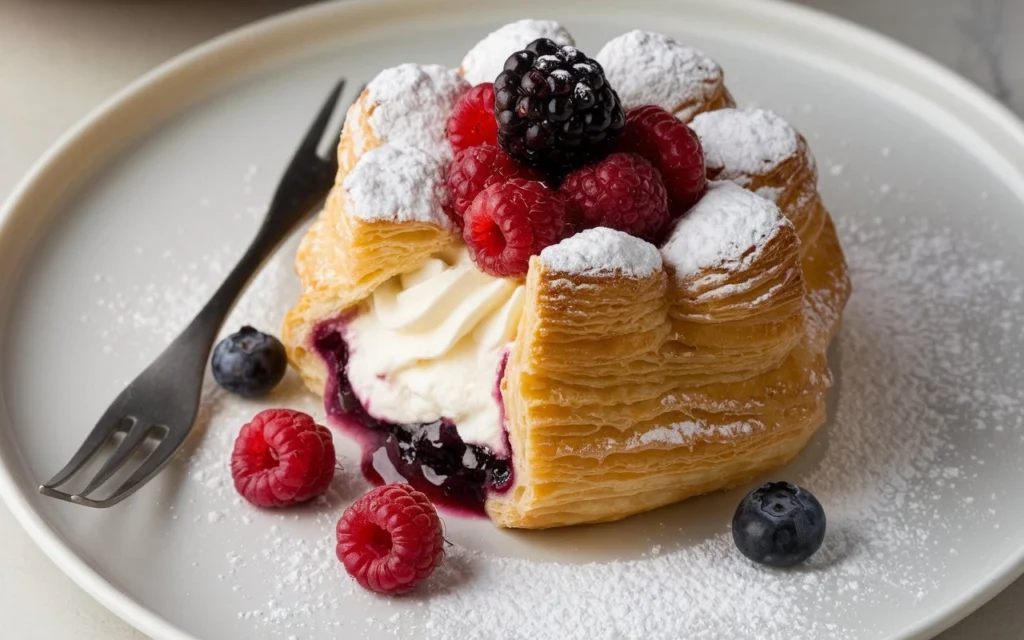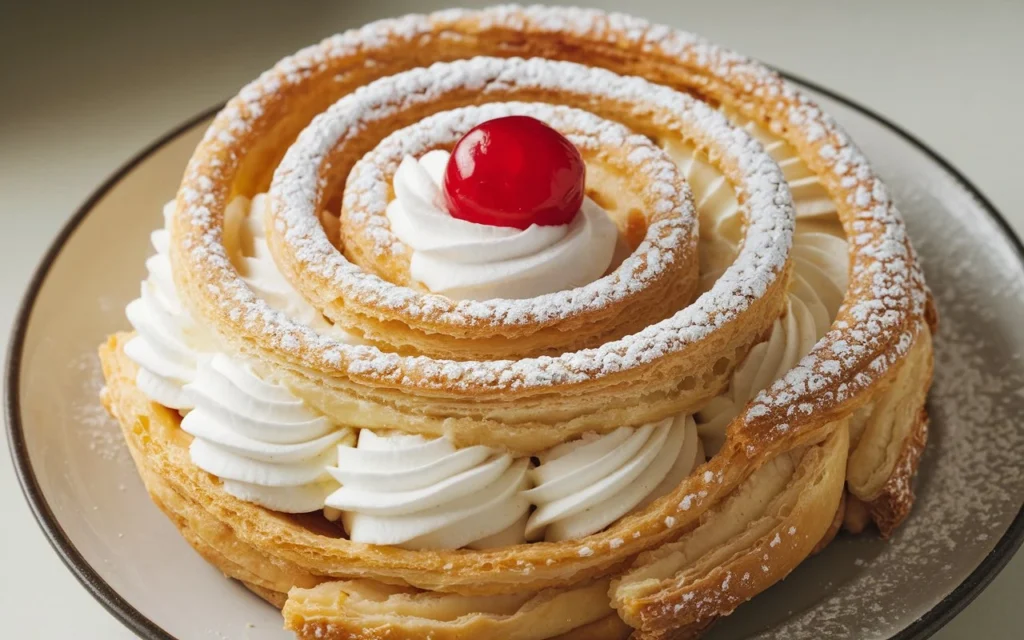Introduction
When it comes to indulgent, flaky, and buttery delights, few things compare to a perfectly baked puff pastry dessert. From the golden layers of a croissant to the crispy crunch of a palmier, puff pastry has an irresistible charm. This culinary wonder isn’t just for expert bakers—it’s accessible to home bakers too. In this comprehensive guide, we’ll explore everything you need to know about puff pastry desserts. You’ll discover its origins, learn how to make it from scratch, and master both classic and modern dessert recipes. Whether you’re a seasoned baker or a curious beginner, this guide has you covered.
Few desserts can match the elegance and versatility of a perfectly baked puff pastry dessert. Its golden, flaky layers and buttery aroma have the power to turn simple ingredients into mouthwatering masterpieces. From classic French croissants to modern cronut hybrids, puff pastry has become a cornerstone of both professional patisseries and home kitchens.
This guide will walk you through every aspect of puff pastry desserts, from understanding its origins to mastering the techniques behind its magical layers. Whether you’re craving a crispy palmier, a fruit-filled turnover, or a delicate galette, you’ll soon be equipped with the skills and knowledge to make it all. By the end of this guide, you’ll know how to create both classic and modern puff pastry desserts with confidence.
So, roll up your sleeves, grab some butter, and get ready to transform simple dough into golden, flaky perfection. Let’s begin with Part 2 — understanding the magic behindpuff pastry.

Understanding Puff Pastry
What is Puff Pastry?
puff pastry is a unique dough known for its light, crisp, and flaky texture. What makes it so special is its structure—multiple layers of dough and butter stacked on top of each other, folded and rolled repeatedly through a process called “lamination.” Unlike traditional doughs that rely on yeast or baking powder for leavening, puff pastry puffs up thanks to the steam released from the butter as it bakes. This process creates hundreds of thin, airy layers, giving it that iconic “puff.”
The dough itself is made from just four simple ingredients: flour, water, salt, and butter. While the ingredient list is short, the process requires precision. Cold butter is essential to maintain distinct layers, and every fold and chill period is crucial for the final result.
Puff pastry desserts are loved worldwide for their versatility. From savory appetizers to sweet treats, puff pastry can be twisted, folded, and shaped into everything from turnovers to tart shells. Its ability to turn ordinary ingredients into bakery-worthy creations is why it’s so beloved by home bakers and pastry chefs alike.
History and Origin of Puff Pastry
The history of puff pastry is as rich as its buttery flavor. It’s widely believed that puff pastry, or “pâte feuilletée,” originated in 17th-century France. Legend has it that a French pastry chef named Claude Lorrain accidentally discovered the technique while trying to make a lighter bread for his father, who was ill. By layering butter into the dough, he inadvertently created the very first version of modern puff pastry.
Although France claims much of the credit for popularizing it, variations of layered doughs existed in other cultures as well. Middle Eastern baklava, for example, uses thin sheets of dough layered with butter, though it’s not technically puff pastry. Spain’s milhojas (meaning “a thousand layers”) also features thin, crispy layers similar to those in puff pastry.
Over time, French pastry chefs refined and formalized the lamination process, making it a staple in French patisserie. Today, puff pastry desserts like croissants, palmiers, and mille-feuille (Napoleon) are global favorites, enjoyed in bakeries, cafes, and homes around the world.
The Science Behind Puff Pastry’s Flakiness
Have you ever wondered how puff pastry gets those irresistibly flaky layers? The secret lies in the process of “lamination,” where layers of dough and butter are stacked, folded, and rolled repeatedly. The goal of lamination is to create hundreds of alternating layers of butter and dough. But here’s the magic part: when the pastry is baked, the water content in both the butter and the dough turns to steam. This steam pushes the layers apart, creating the distinct “puff” that gives puff pastry its name.
Here’s how it works:
- The Fold: Butter is placed in the center of the dough, which is then folded like a letter.
- The Roll: The dough is rolled flat and then folded again. Each fold increases the number of layers.
- The Chill: Chilling the dough between folds keeps the butter from melting, which preserves the layers.
- The Bake: When baked, steam from the butter expands, lifting each layer to create that light, airy texture.
Every fold doubles the layers, so after just 6 folds, you can have up to 729 layers of dough and butter! That’s why precision and patience are so important. If the butter gets too soft, it blends into the dough, ruining the structure. But if you master the technique, you’ll be rewarded with ultra-crispy, golden-brown puff pastry desserts that taste just as good as they look.

Types of Puff Pastry Desserts
Classic Puff Pastry Desserts
Croissants
When people think of puff pastry desserts, croissants often come to mind. This iconic French pastry is beloved for its rich, buttery flavor and light, flaky texture. Unlike traditional puff pastry, croissants use a variation called “yeasted laminated dough,” but the concept is similar. Layers of butter and dough are folded multiple times to create airy layers that “puff” during baking.
The process of making croissants is a labor of love. From chilling the dough to precise folding and resting, it requires time, patience, and precision. But the result? Absolute perfection. Freshly baked croissants have a crisp exterior and a soft, honeycomb-like interior. Croissants have become a breakfast staple worldwide, often filled with chocolate, almond cream, or ham and cheese for a savory twist.
Palmiers
Palmiers are one of the simplest yet most elegant puff pastry desserts. Also known as “elephant ears,” these pastries are made by rolling puff pastry with sugar, then folding the dough into a heart shape before slicing and baking. As they bake, the sugar caramelizes, giving palmiers their signature crispy, golden shell.
What makes palmiers so appealing is their simplicity. They require only two main ingredients—puff pastry and sugar—but the result is an eye-catching, sweet, and crispy delight. These bite-sized treats are perfect for tea parties, dessert platters, or simple snacks. While traditional palmiers use sugar, modern variations use cinnamon, chocolate, or even savory ingredients like cheese.
Turnovers
Turnovers are perhaps the most versatile puff pastry desserts you can make. They’re small, hand-held pastries filled with sweet or savory fillings, often folded into triangles or rectangles. The sweet versions are commonly filled with fruit, such as apples, cherries, or berries, but cream cheese and chocolate variations are also popular.
The key to a perfect turnover is sealing the edges properly to prevent the filling from leaking out. Bakers often crimp the edges with a fork for a decorative finish. Turnovers are quick, portable, and customizable, which is why they remain a bakery favorite. They’re also one of the easiest desserts to make with store-bought puff pastry, allowing home bakers to whip up a batch in no time.
Modern Innovations in Puff Pastry Desserts
Cronuts
What happens when you combine a croissant with a doughnut? You get the wildly popular cronut. This hybrid dessert burst onto the scene in 2013, created by Dominique Ansel Bakery in New York City. It blends the buttery layers of a croissant with the fried, sweet exterior of a doughnut, and it became a viral sensation almost overnight.
Unlike traditional puff pastry desserts, cronuts are deep-fried, which gives them a golden, crispy exterior. After frying, they’re typically coated with sugar, filled with cream, and topped with glaze. The demand for cronuts was so high that bakeries worldwide started offering their own versions. Though the original cronut remains iconic, countless twists on the concept have since emerged.
Puff Pastry Tarts
Tarts have always been a popular dessert, but modern puff pastry tarts bring a fresh twist to the classic concept. Instead of traditional tart dough, these tarts are made using puff pastry, which gives them a lighter, flakier base.
The beauty of puff pastry tarts lies in their versatility. They can be sweet or savory, large or mini, and topped with fruits, custards, or even chocolate. One trendy modern variation is the “fruit rose tart,” where thinly sliced fruit is arranged in a rose-like pattern on top of the pastry. Other variations include caramelized onion tarts, custard tarts, and mini dessert bites. Puff pastry tarts are perfect for elegant desserts that look like they took hours to make but actually come together in no time.
Making Puff Pastry Desserts at Home
Choosing Between Store-Bought and Homemade Puff Pastry
When it comes to making puff pastry desserts, one of the biggest decisions is whether to use store-bought or homemade puff pastry. Each option has its own perks and drawbacks.
Store-bought puff pastry is a game-changer for home bakers. It’s pre-laminated, frozen, and ready to roll (literally). If you’re short on time or prefer convenience, store-bought puff pastry allows you to skip the lengthy lamination process. Plus, it’s consistent in quality and easy to handle once thawed. However, store-bought versions may include preservatives, and they often lack the rich, buttery flavor of homemade dough.
Homemade puff pastry, on the other hand, is the gold standard. It allows you to control every ingredient, from the type of butter to the level of sweetness. While it takes more effort and time, the flavor and texture are unmatched. Homemade puff pastry is fresher, more flavorful, and offers the satisfaction of creating something from scratch. If you have the time and patience, making puff pastry from scratch is a rewarding experience that elevates the taste of your puff pastry desserts.
Step-by-Step Guide to Making Puff Pastry from Scratch
Making puff pastry at home may seem intimidating, but with patience and precision, you’ll master it in no time. Here’s a step-by-step guide to help you get those flaky layers just right.
Ingredients:
- 2 ½ cups all-purpose flour
- 1 cup cold unsalted butter (cubed)
- ½ cup ice-cold water
- 1 tsp salt
Instructions:
- Prepare the Dough (Détrempe): In a large bowl, combine the flour and salt. Add the cold butter cubes and gently mix, keeping the butter in small chunks. Slowly pour in the ice water, mixing until a rough dough forms. Shape it into a square, wrap it in plastic, and chill for 30 minutes.
- Create the Butter Block (Beurrage): While the dough rests, prepare the butter block. Flatten the butter into a square about the size of your dough. Use parchment paper to shape it into an even, flat block. Chill for 15-20 minutes.
- Lamination: Roll out the dough into a rectangle, place the butter block in the center, and fold the dough like a letter (fold one-third in, then the other third over it). Roll it out and fold it again. This process is called a “turn.” Repeat 4-6 turns, chilling the dough for 20-30 minutes after every turn to keep the butter firm.
- Final Chill: Once you’ve completed all the folds, chill the dough for 1-2 hours before using. This step ensures the butter stays intact, which helps achieve those flaky layers.
Pro Tips:
- Work in a cool environment to prevent the butter from melting.
- Don’t overwork the dough—gentle handling preserves the layers.
- Use a light dusting of flour to prevent sticking, but avoid using too much as it can toughen the dough.
Once you’ve mastered this method, you’ll never look at store-bought puff pastry the same way again. Your homemade puff pastry desserts will taste fresher, richer, and more flavorful.
Essential Tools for Puff Pastry Baking
To make puff pastry desserts successfully, having the right tools makes all the difference. Here are the essential items you’ll need:
- Rolling Pin: This is a must-have for rolling out the dough. A heavy, solid rolling pin offers better control and even pressure.
- Pastry Brush: Use this to apply egg wash for a golden finish on pastries. It also helps remove excess flour from the dough.
- Baking Sheet: Since puff pastry “puffs” as it bakes, a flat, non-stick baking sheet ensures even baking. Line it with parchment paper to prevent sticking.
- Bench Scraper: This tool helps lift, fold, and cleanly cut dough without tearing.
- Cooling Rack: Cooling your baked desserts on a rack allows air to circulate, keeping the bottom crisp.
With these tools in your kitchen, you’ll be able to prepare, bake, and present flawless puff pastry desserts every time.
Common Mistakes to Avoid
Even experienced bakers make mistakes with puff pastry, but knowing the common pitfalls can help you avoid them. Here are some of the most frequent issues and how to prevent them:
- Using Warm Butter: Warm butter melts into the dough, destroying the layers. Always keep the butter cold and firm during lamination.
- Skipping Chill Time: Rushing through chilling steps weakens the layers, resulting in a dense, under-risen pastry. Patience is key!
- Overworking the Dough: Handling the dough too much causes gluten to develop, making the pastry tough rather than tender. Use a light touch.
- Not Sealing Turnovers Properly: If the edges of turnovers aren’t sealed, fillings can leak during baking. Crimp edges tightly with a fork.
- Overbaking or Underbaking: Underbaked pastry is doughy, while overbaking burns the delicate edges. Bake until golden brown, following the recipe’s time guidelines.
By avoiding these mistakes, you’ll achieve perfectly crisp, golden puff pastry desserts every time.
FAQs on Puff Pastry Desserts
What are some easy puff pastry desserts for beginners?
If you’re new to puff pastry, start with simple treats like palmiers, fruit turnovers, or puff pastry pinwheels. These recipes use minimal ingredients and don’t require complicated techniques.
Can puff pastry be made gluten-free?
Yes, gluten-free puff pastry is possible, but it’s more challenging to achieve the same flaky texture. Gluten-free flours lack the elasticity of wheat flour, so you may need to use xanthan gum or gluten-free flour blends for the best results.
How do I store leftover puff pastry desserts?
Once baked, let your desserts cool completely before storing them. For short-term storage, keep them in an airtight container at room temperature for up to 2 days. If you want to preserve them longer, freeze them in a sealed container.
Is it possible to make vegan puff pastry?
Yes, you can make vegan puff pastry by replacing butter with plant-based margarine or vegan butter. Many store-bought puff pastry brands are already vegan-friendly, but check the label to be sure.
Why does my puff pastry not rise properly?
If your puff pastry doesn’t rise, it could be due to several issues. The butter may have melted into the dough during lamination, the dough may not have been chilled long enough, or it could have been rolled too thin. Keep everything cold, follow proper folding techniques, and avoid over-handling the dough.
Conclusion
Puff pastry desserts are a perfect blend of elegance and flavor. From crispy palmiers to rich turnovers and fruit galettes, this versatile dough creates magical desserts that look as stunning as they taste. Whether you use store-bought pastry for convenience or try your hand at making it from scratch, the results are always delicious. With the right tools, proper techniques, and a bit of patience, you can master puff pastry at home. So, don’t wait—grab your rolling pin, and let the adventure begin!


